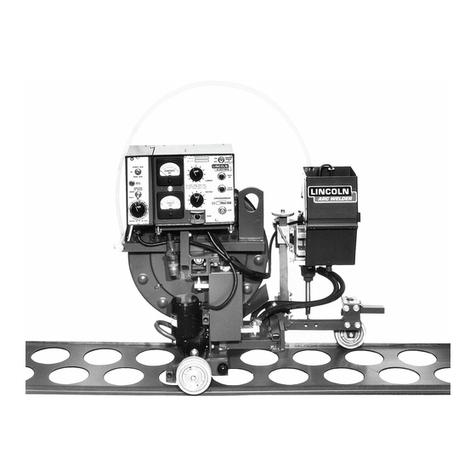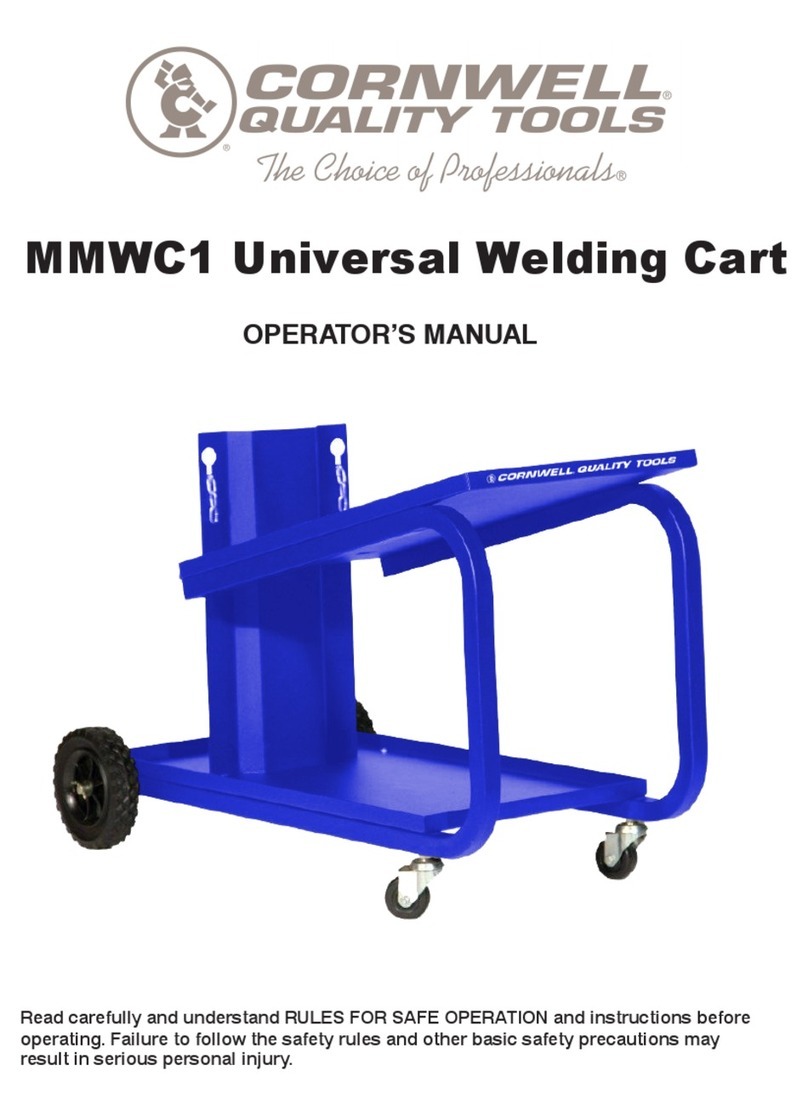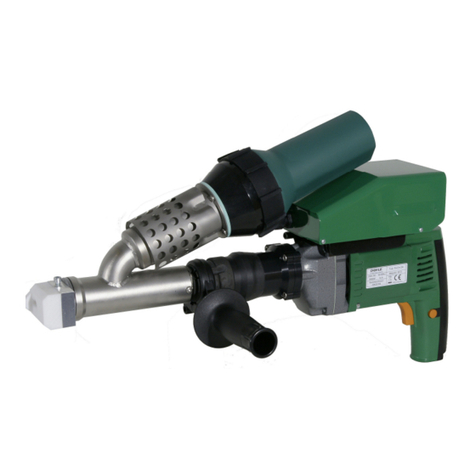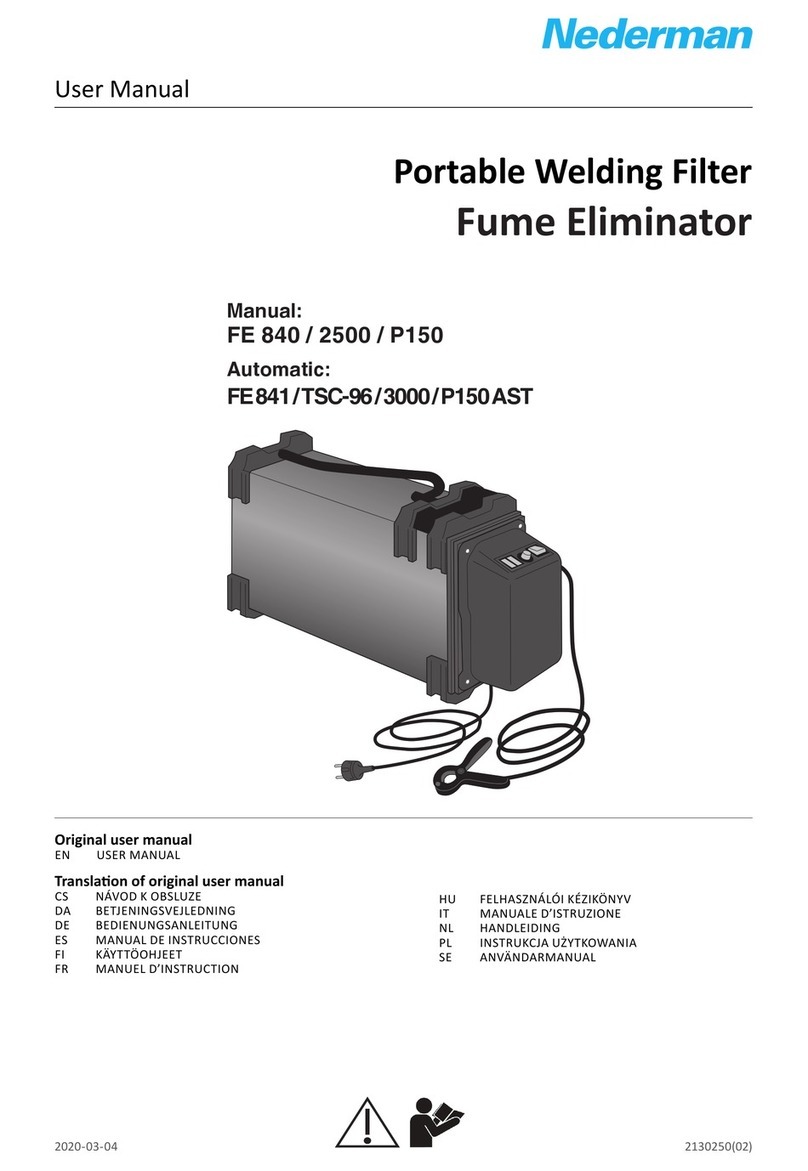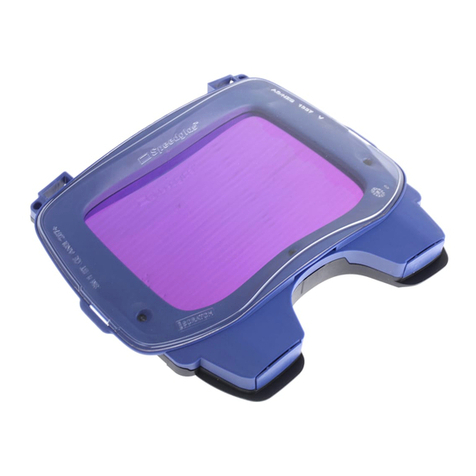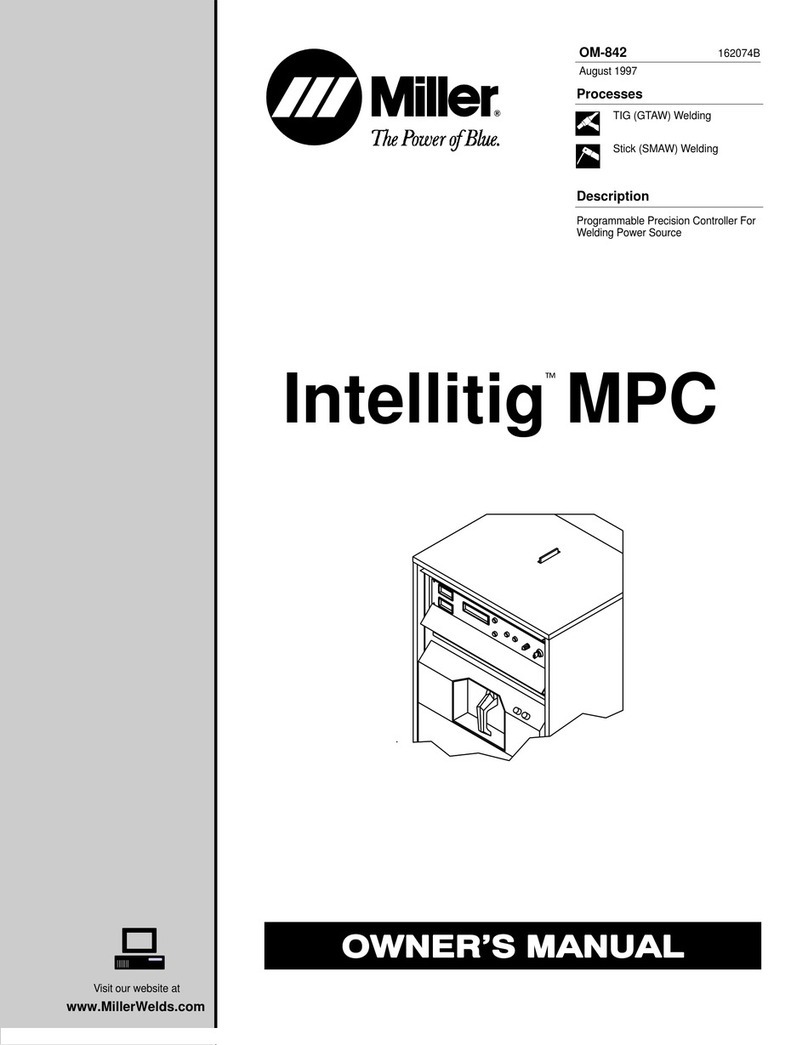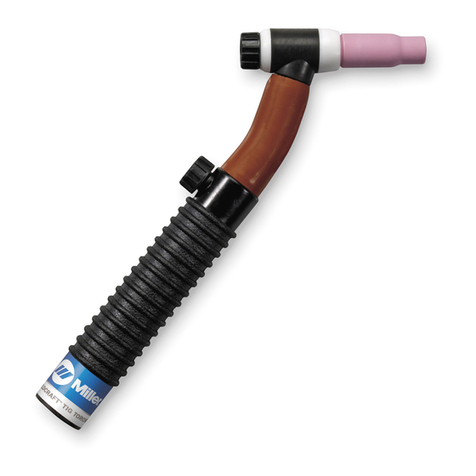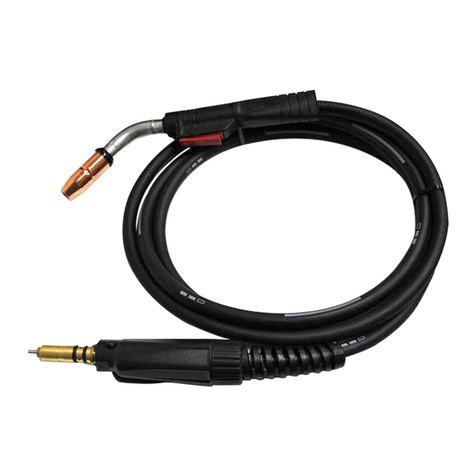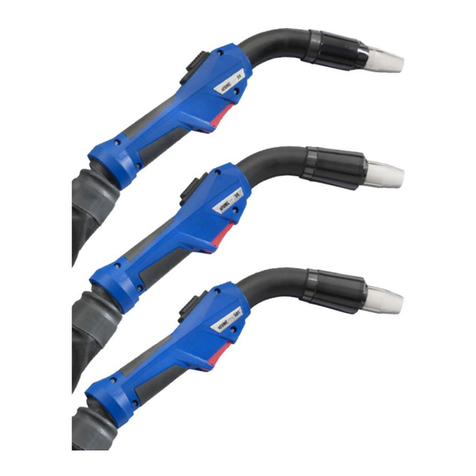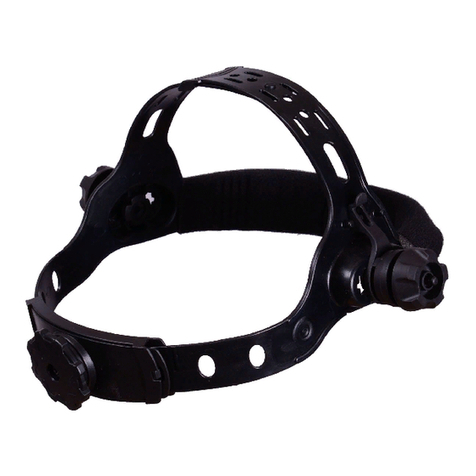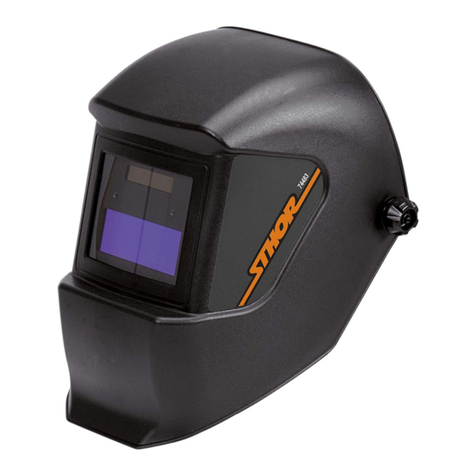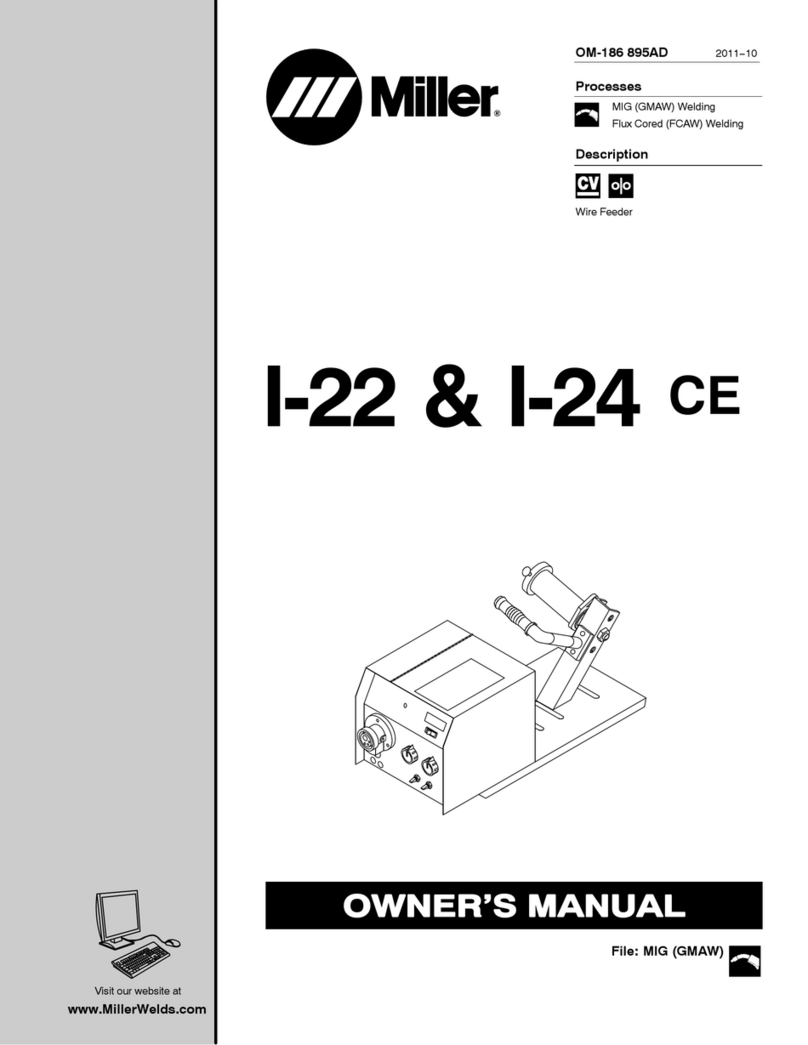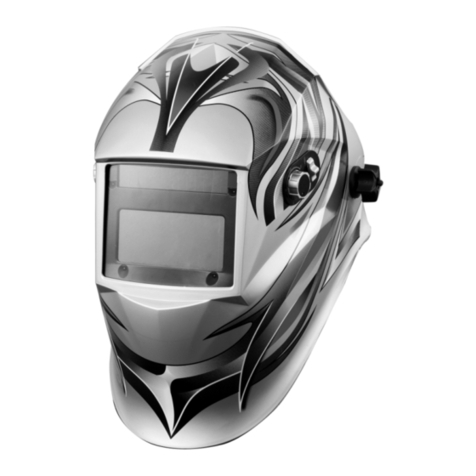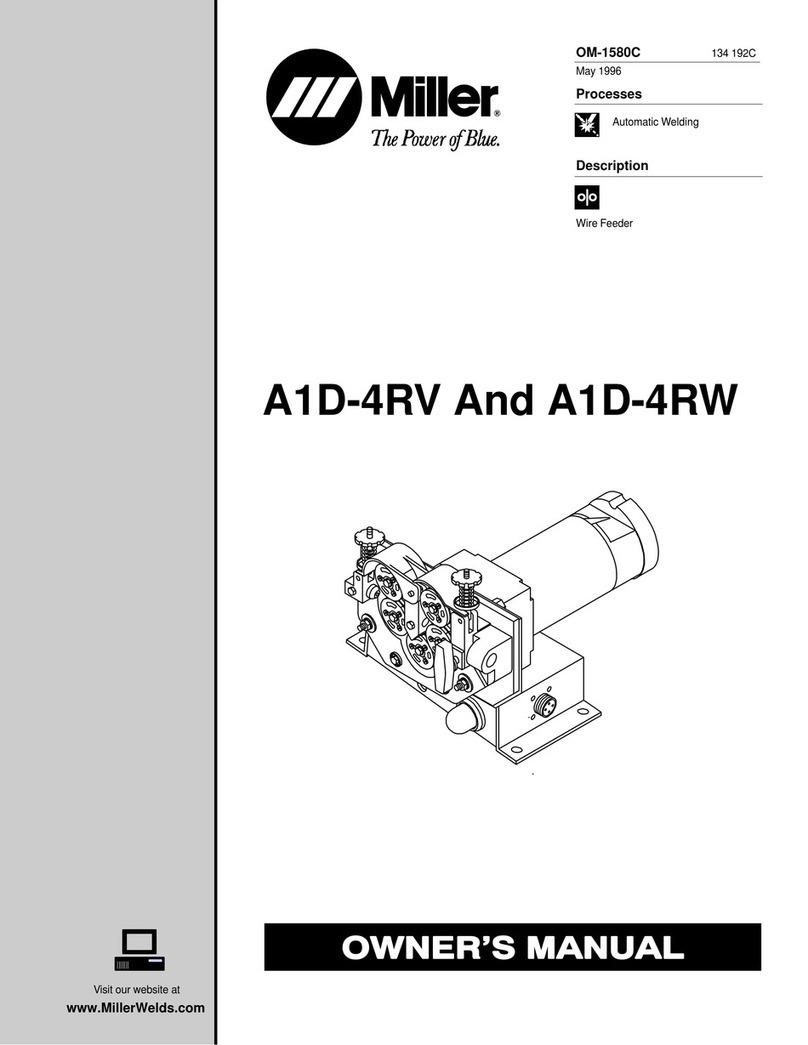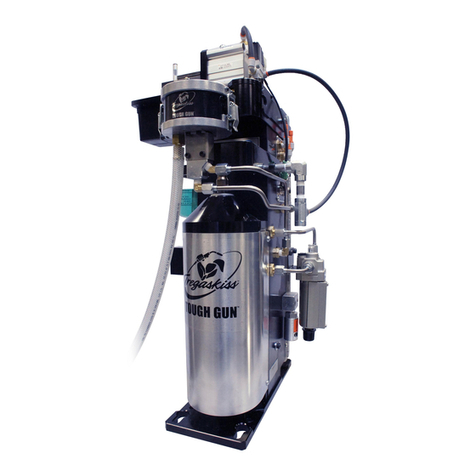SWP Stealth-XG 6044 User manual

IMPORTANT NOTICE
Please read these instructions carefully before using this unit
Failure to comply with the instructions may void your warranty and adversely affect your
health and safety
Weld & Grind Helmet
& Digi-Air PAPR System
Part No. 6044/6044BT
OPERATORS’ MANUAL
Version 1.1 – Last updated 06.11.2020

2
1. INTRODUCTION
Respirator system is intended to be used to provide protection when the user working in
the contamination environment. The equipment is able to filter the contaminate air via
the filter build in to the blower and then supply fresh air from breathing tube to the
welding faceshield, so that the user can continually working in contamination
environment. It is a combined face and breathing protection device for increased safety
and comfort during welding. Please read these instructions carefully before unpacking.
For proper use, see user instructions or contact manufacturers for help.
2. APPROVALS
The system complies with the requirements of PPE Regulation 2016/425 and
European Standard EN 12941: 1998+A2:2008 class TH3 P R S L . The respirator
system is designed to provide a supply of filtered air via a breathing tube to a welding
headpiece. The equipment can be used in environment that requires a class TH3P
breathing protection device. It protects against articulate contamination.
All components used in respirator system must be manufacturer approved parts, and
must be used in accordance with the instructions in this manual.
1. The approval is not valid if the product is incorrectly used together
with non-approved parts or components.
2. Only the particle filter and pre-filter can be used together with this
system. Filters fromother manufacturersshould under nocircumstances
be used.
PAPR PRECAUTIONS
Notified Body: Vyzkumny ustav bezpecnosti prace, v. v. i., Jeruzalémská 1283/9, 11
0 00 Praha 1, Czech Republic (Notified body number 1024)

2
1. INTRODUCTION
Respirator system is intended to be used to provide protection when the user working in
the contamination environment. The equipment is able to filter the contaminate air via
the filter build in to the blower and then supply fresh air from breathing tube to the
welding faceshield, so that the user can continually working in contamination
environment. It is a combined face and breathing protection device for increased safety
and comfort during welding. Please read these instructions carefully before unpacking.
For proper use, see user instructions or contact manufacturers for help.
2. APPROVALS
The system complies with the requirements of PPE Regulation 2016/425 and
European Standard EN 12941: 1998+A2:2008 class TH3 P R S L . The respirator
system is designed to provide a supply of filtered air via a breathing tube to a welding
headpiece. The equipment can be used in environment that requires a class TH3P
breathing protection device. It protects against articulate contamination.
All components used in respirator system must be manufacturer approved parts, and
must be used in accordance with the instructions in this manual.
1. The approval is not valid if the product is incorrectly used together
with non-approved parts or components.
2. Only the particle filter and pre-filter can be used together with this
system. Filters fromother manufacturersshould under nocircumstances
be used.
PAPR PRECAUTIONS
Notified Body: Vyzkumny ustav bezpecnosti prace, v. v. i., Jeruzalémská 1283/9, 11
0 00 Praha 1, Czech Republic (Notified body number 1024)
3
2
3.WARNING AND LIMITATIONS TO USE
Before each use, inspect the respirator system for damage and verify it operates
properly. Before using the respirator system, test air flow to verify it is providing an
adequate volume of air.
Always wear the respirator system and do not remove the head top or turn off the air
filter unit until outside the contaminated area, otherwise, there is a risk of high
concentration of CO2and oxygen level in the head top will fall, thus little or no protection
is given.
If you are not sure about the concentration of pollution, or about equipment performance,
ask the industrial safety engineer.
T
he manufacturer is not responsible for injury due to the following
incorrect use or incorrect choice of equipment.
Warning:
This respirator devices should be used with well trained person and qualified person
only.
Before using the devices ensure you have understood that at very high work rates the
pressure in the device may become negative at peak inhalation flow.
Before and during using the devices, attention shall be drawn to possible incorrect use
and, where appropriate, the possibility of looped hoses and/or cables becoming caught
up.
Before or during using the devices if the devices in the power-off state little or no
respirator protection is to be expected, and that this is considered to be an abnormal
situation.
Please leave the work place and remove the headgear, when the devices in the
power-off state a rapid build-up of carbon dioxide and depletion of oxygen within the
hood may occur.
The filters shall only be fitted to the turbo unit and not directly to the helmet/hood.
The user should not confuse the markings on a filter relating to any standard other than
EN 12941 with the classification of this device when used with this filter.
DO NOT use SparX Air with the blower unit switched off.

4
3
or health and/or has oxygen content of less than 19.5% or contains unknown
substances.
DO NOT use Stealth-XG in an explosive atmosphere.
DO NOT use Stealth-XG in confined spaces or areas of poor ventilation
DO NOT use Stealth-XG in high winds.
DO NOT alter or modify in any way.
DO NOT touch any of the moving parts.
DO NOT allow water or other liquids to enter the impeller chamber, the filter or battery
compartment.
4. UNPACKING/ASSEMBLY
Check that correct number of components has been supplied, as in figure 1.
Check that the apparatus is complete, undamaged and correctly assembled.
Any damaged or defective parts must be replaced before use.
FIGURE 1
The package must include:
1. The helmet with airduct
2. The respirator protection system (turbo unit + filter + waist belt)
3. Li-ion rechargeable battery
4. The tube with anti-fire cloth and both end fittings
5. The shoulder harness
DO NOT use Stealth-XG in an atmosphere
2that is immediately hazardous to user hygiene
3.WARNING AND LIMITATIONS TO USE
Before each use, inspect the respirator system for damage and verify it operates
properly. Before using the respirator system, test air flow to verify it is providing an
adequate volume of air.
Always wear the respirator system and do not remove the head top or turn off the air
filter unit until outside the contaminated area, otherwise, there is a risk of high
concentration of CO2and oxygen level in the head top will fall, thus little or no protection
is given.
If you are not sure about the concentration of pollution, or about equipment performance,
ask the industrial safety engineer.
The manufacturer is not responsible for injury due to the following
incorrect use or incorrect choice of equipment.
Warning:
This respirator devices should be used with well trained person and qualified person
only.
Before using the devices ensure you have understood that at very high work rates the
pressure in the device may become negative at peak inhalation flow.
Before and during using the devices, attention shall be drawn to possible incorrect use
and, where appropriate, the possibility of looped hoses and/or cables becoming caught
up.
Before or during using the devices if the devices in the power-off state little or no
respirator protection is to be expected, and that this is considered to be an abnormal
situation.
Please leave the work place and remove the headgear, when the devices in the
power-off state a rapid build-up of carbon dioxide and depletion of oxygen within the
hood may occur.
The filters shall only be fitted to the turbo unit and not directly to the helmet/hood.
The user should not confuse the markings on a filter relating to any standard other than
EN 12941 with the classification of this device when used with this filter.
DO NOT use Stealth-XG with the blower unit switched off.

5
4
6. The air flow tester
7. The lithium-ion battery charger
8. The carrying bag
If any of the above components are not included in your kit, please contact the supplier
immediately.
4.1 Filter replacement
1
Remove the filter cover by pressing in the
latch of the filter cover.
2
The filter cover is released.
3
Remove the used filter by lifting it out from
the filter cover.
4
5
Remove the pre-filter.
6
Clean the spark arrestor if necessary.
If the filter is wet or heavily loaded with particles or damaged, it should
be replaced.Never attempt to clean the filter by any means, it can damage
the filter media easily. The pre-filter (if used) should be intact
without any
tears
or cuts.Please replace the prefilter once it's wet or heavily loaded
with
particulate.
4
3
or health and/or has oxygen content of less than 19.5% or contains unknown
substances.
DO NOT use Stealth-XG in an explosive atmosphere.
DO NOT use Stealth-XG in confined spaces or areas of poor ventilation
DO NOT use Stealth-XG in high winds.
DO NOT alter or modify in any way.
DO NOT touch any of the moving parts.
DO NOT allow water or other liquids to enter the impeller chamber, the filter or battery
compartment.
4. UNPACKING/ASSEMBLY
Check that correct number of components has been supplied, as in figure 1.
Check that the apparatus is complete, undamaged and correctly assembled.
Any damaged or defective parts must be replaced before use.
FIGURE 1
The package must include:
1. The helmet with airduct
2. The respirator protection system (turbo unit + filter + waist belt)
3. Li-ion rechargeable battery
4. The tube with anti-fire cloth and both end fittings
5. The shoulder harness
DO NOT use Stealth-XG in an atmosphere
2that is immediately hazardous to user hygiene
3.WARNING AND LIMITATIONS TO USE
Before each use, inspect the respirator system for damage and verify it operates
properly. Before using the respirator system, test air flow to verify it is providing an
adequate volume of air.
Always wear the respirator system and do not remove the head top or turn off the air
filter unit until outside the contaminated area, otherwise, there is a risk of high
concentration of CO2and oxygen level in the head top will fall, thus little or no protection
is given.
If you are not sure about the concentration of pollution, or about equipment performance,
ask the industrial safety engineer.
The manufacturer is not responsible for injury due to the following
incorrect use or incorrect choice of equipment.
Warning:
This respirator devices should be used with well trained person and qualified person
only.
Before using the devices ensure you have understood that at very high work rates the
pressure in the device may become negative at peak inhalation flow.
Before and during using the devices, attention shall be drawn to possible incorrect use
and, where appropriate, the possibility of looped hoses and/or cables becoming caught
up.
Before or during using the devices if the devices in the power-off state little or no
respirator protection is to be expected, and that this is considered to be an abnormal
situation.
Please leave the work place and remove the headgear, when the devices in the
power-off state a rapid build-up of carbon dioxide and depletion of oxygen within the
hood may occur.
The filters shall only be fitted to the turbo unit and not directly to the helmet/hood.
The user should not confuse the markings on a filter relating to any standard other than
EN 12941 with the classification of this device when used with this filter.
DO NOT use Stealth-XG with the blower unit switched off.

6
5
4.2 Installing the battery/Charging
1
Slide the battery towards the back of the
filtration unit.
2
Make sure that the battery is locked in
position.
3
The battery can be charged on the filtration unit or separately.
T
he battery is partially charged when delivered. It must be charged at a
1
00% (4 bars) before the first use.
It is recommended to charge the batteries at a 100% before each use.
T
he charger must not be used for anything else than it was designed for.
D
o not charge the battery in a potentially explosive area. The charger
m
ust only be used indoors.
T
he charger regulates the charge automatically, once the battery is fully
charged, it will maintain it at a 100% (floating charge).
The charge time is 3 to 4 hours.
T
he battery will discharge itself after long storage periods. Always charge
t
he battery if the device was stored for more than 15 days. When the
battery is new or has been stored for more than 3 months, charge it and
discharge it at least twice in a row to reach the nominal/rated charge
capacity.

6
5
4.2 Installing the battery/Charging
1
Slide the battery towards the back of the
filtration unit.
2
Make sure that the battery is locked in
position.
3
The battery can be charged on the filtration unit or separately.
T
he battery is partially charged when delivered. It must be charged at a
1
00% (4 bars) before the first use.
It is recommended to charge the batteries at a 100% before each use.
T
he charger must not be used for anything else than it was designed for.
D
o not charge the battery in a potentially explosive area. The charger
m
ust only be used indoors.
T
he charger regulates the charge automatically, once the battery is fully
charged, it will maintain it at a 100% (floating charge).
The charge time is 3 to 4 hours.
T
he battery will discharge itself after long storage periods. Always charge
t
he battery if the device was stored for more than 15 days. When the
battery is new or has been stored for more than 3 months, charge it and
discharge it at least twice in a row to reach the nominal/rated charge
capacity.
7
6
Battery charge :
1. Connect the battery to the charger. The connector is above the battery.
2. Connect the charger to the mains.
3. The state of charge is displayed via a red LED on the mains charger.
4. Once the charge is finished, the floating charge becomes active: the red LED
switches off and a green LED switches on.
5. Disconnect the charger from the mains (do not keep the charger plugged to the
mains if it’s not in use).
4.3 Installing the respirator system on the belt
1
Remove the belt’s release buckle.
2
Remove the fastening belt from the waist
connector’s 2 belt loops.
3
Make the fastening belt pass through the
respirator system’s 2 belt loops.
4
Position the Velcro® between the 2 loops.
5
Flip the filtration system and attach the
Velcro on the belt.
6
Put the fastening belt back through the 2 belt
loops.

8
7
7
Put the buckle back.
8
Attach the harness to the belt’s 4 plastic
rings.
M
ake sure the belt is securely fastened.
4.4 Connecting the tube
1
Connect the air tube to the respirator
system and twist it clockwise to lock its
position.
2
Connect the other end of the tube to the
headgear in the same way.
1
.Check that the respiratory tube is strongly connected. If the tube is
broken, replace it.
A
ll components must be installed/ used in accordance with this manual if
the equipment is to offer the specified protection. If any component is
missing, or if anything is not clear, contact the supplier.

8
7
7
Put the buckle back.
8
Attach the harness to the belt’s 4 plastic
rings.
M
ake sure the belt is securely fastened.
4.4 Connecting the tube
1
Connect the air tube to the respirator
system and twist it clockwise to lock its
position.
2
Connect the other end of the tube to the
headgear in the same way.
1
.Check that the respiratory tube is strongly connected. If the tube is
broken, replace it.
A
ll components must be installed/ used in accordance with this manual if
the equipment is to offer the specified protection. If any component is
missing, or if anything is not clear, contact the supplier.
9
8
5. BEFORE USE/ FITTING
5.1 Air flow test
1
Connect the breathing tube to the turbo unit
and twist it clockwise to lock it.
2
Insert the flowmeter at the tip of the tube.
3
Press the ON button and maintain the tube
in a vertical position at eyes’ height.
4
The air flow is sufficient if the marble
reaches the minimum flow level O.
1. The airflow must be tested before using.
2. If the marble can’t reach the minimum flow level, don’t use the system.
Change the filter or the battery and retest the air flow.

10
9
5.2 Air flow alarm test
1
Remove the tube from the helmet and press
the ON button.
2
Cover the air output with your hand and wait
approximately 15 seconds.
If the alarm does not work, please repair or change respirator system.
5.3 Fitting
Make sure the face seal is positioned properly, otherwise, you can’t get
sufficient sealing needed to offer the correct protection factor.
Adjust the tightness of the face seal and put
on the head top.
Adjust the headgear to suitable tightness
( turn left to loosen, turn right to tighten)
1
2

11
10
6. LCD and Operation
6.1 LCD display screen
There is a LCD display screen on Stealth-XG unit to show the Stealth-XG working
condition (FIGURE 3).
FIGURE 3
Part 1 shows the data of current air flow.
Part 2 shows the level of the airflow.
Part 3 shows the filter condition.
Part 4 shows the battery.
Part 5 shows the temperature of the battery.
Any of them will flash if there are Stealth-XG disfunctions.
Part1Part3
Part2 Part4
Part5

12
11
6.2 Operation
S
witch the device on by pressing the ON button once.
P
ress the ON button once again, the air flow is at level 1 (~170L/min).
P
ress the ON button once again, the air flow is at level 2 (~200L/min).
P
ress the ON button once again, the air flow is at level 3 (~230L/min)
.
P
ress the ON button once again, the air flow reverts to level 1 (~170L/min)
.
1
. The respirator system will turn off the turbo unit if long press the OFF
button more than 3 seconds.
2. The respirator system will cut off the entire circuit and switch to sleep mode if
the turbo unit has turned off for more than 30 minutes. Pressing the ON button
can activate the system.
3. The respirator system must be operated in the temperature range of
-5℃to +55℃and relative humidity less than 90%RH.

12
11
6.2 Operation
S
witch the device on by pressing the ON button once.
P
ress the ON button once again, the air flow is at level 1 (~170L/min).
P
ress the ON button once again, the air flow is at level 2 (~200L/min).
P
ress the ON button once again, the air flow is at level 3 (~230L/min)
.
P
ress the ON button once again, the air flow reverts to level 1 (~170L/min)
.
1
. The respirator system will turn off the turbo unit if long press the OFF
button more than 3 seconds.
2. The respirator system will cut off the entire circuit and switch to sleep mode if
the turbo unit has turned off for more than 30 minutes. Pressing the ON button
can activate the system.
3. The respirator system must be operated in the temperature range of
-5℃to +55℃and relative humidity less than 90%RH.
13
14
7. MAINTANCE & STORAGE
Inspect the equipment daily and always check it if any sign of malfunction occurs.
7.1 Maintenance
The respirator system unit must be checked regularly and must be changed if it is
damaged and cause leakage.
The filter must be changed if it is broken, or it is blocked and does not give enough
airflow.
The breathing tube must be changed if it is broken or has crevasse.
The battery must be charged when the low battery alarm rings.
Use a soft cloth to wipe the external surfaces. Don’t use water!
Disinfect the equipment with disinfectant not having any adverse effect on the PPE or
the user. Dettol disinfectant is recommended. Dilute the disinfectant and water in a ratio
of 1:99. Wipe the surface of the equipment with a clean lint-free tissue or cloth that takes
the solvent. Then wipe the surface of the equipment with another clean lint-free tissue or
cloth that takes water.
The filter should be replaced together with the pre-filter.
7.2 Storage
The respirator system must be stored in a dry, clean area, in the temperature range of
-10℃to +55℃and relative humidity less than 90%RH.
If the equipment is stored at temperature below 0℃, the battery must be allowed to
warm up to achieve full battery capacity. The equipment must be protected from dust,
particles and other contamination.
If the equipment is not used for a long time, the battery should be fully charged, removed
from the respirator system unit and stored separately.
Transport the equipment with original packaging box and away from direct sunlight.

14
8. TROUBLE SHOOTING
Problem Probable cause Action
Fault code «E01»
+
b
links
1.Motor is stuck
2.Motor is damaged
3.Blower structure failure
caused by outer force
4.Circuit failure
Check and remove physical
failure and restart the system.
Return to dealer if LCD still
shows E01
Fault code «E02»
+
b
links
1.Motor is damaged
2.Motor impeller rubs blower
shell
3.Circuit has excessive
current.
Check and remove physical
failure and restart the system.
Return to dealer if LCD still
shows E02
b
links
+
b
links
+ alarm sounds
Low battery Charge the battery
b
links
+
b
links
+ alarm sounds
Filter blocked
Tube blocked
Remove obstruction, change the
filter
Clean tube
b
links +alarm sounds Battery high temperature Stop working and rest
No air flow, no alarm 1. No power
2.Battery contact damaged
Charge the battery
Check battery contact
Battery run time is too short 1.Battery is not fully charged
2. Filter is blocked
3. Battery is damaged
Charge the battery
Remove obstruction, change
filter
Change battery
Air supply to hood smells
unusual
1. Filter broken
2. Tube broken
3. ADF helmet broken
Leave current area immediately.
1. Change filter
2. Change tube
3. Change ADF helmet
Supply insufficient air to hood 1. Breathing tube broken off
2. Breathing tube broken
3. Filter is blocked
1. Check tube connection to
hood and respirator system unit
2. Change breathing tube
3.Remove obstruction, change
filter

14
8. TROUBLE SHOOTING
Problem Probable cause Action
Fault code «E01»
+
b
links
1.Motor is stuck
2.Motor is damaged
3.Blower structure failure
caused by outer force
4.Circuit failure
Check and remove physical
failure and restart the system.
Return to dealer if LCD still
shows E01
Fault code «E02»
+
b
links
1.Motor is damaged
2.Motor impeller rubs blower
shell
3.Circuit has excessive
current.
Check and remove physical
failure and restart the system.
Return to dealer if LCD still
shows E02
b
links
+
b
links
+ alarm sounds
Low battery Charge the battery
b
links
+
b
links
+ alarm sounds
Filter blocked
Tube blocked
Remove obstruction, change the
filter
Clean tube
b
links +alarm sounds Battery high temperature Stop working and rest
No air flow, no alarm 1. No power
2.Battery contact damaged
Charge the battery
Check battery contact
Battery run time is too short 1.Battery is not fully charged
2. Filter is blocked
3. Battery is damaged
Charge the battery
Remove obstruction, change
filter
Change battery
Air supply to hood smells
unusual
1. Filter broken
2. Tube broken
3. ADF helmet broken
Leave current area immediately.
1. Change filter
2. Change tube
3. Change ADF helmet
Supply insufficient air to hood 1. Breathing tube broken off
2. Breathing tube broken
3. Filter is blocked
1. Check tube connection to
hood and respirator system unit
2. Change breathing tube
3.Remove obstruction, change
filter
15
16
9. SPECIFICATION
3.Remove obstruction, change
filter
Size (Blower Assembly) 9-2/5 x 6-1/2 x 2-3/4 in. (240 x 165 x 70 mm)
Weight 2.4KG
Particle Filter 1*TH3 P R SL
Air Flow Manufacturer minimum design flow rate: 165L/min
Nominal airflow :
Level 1: 170L/min
Level 2: 200L/min
Level 3: 230L/min
Noise Level Max 75dB
Operate Temperature 23℉to 131℉(-5℃~55℃)
Storage temperature 14℉to 131℉(-10℃~55℃)
Battery Type Standard Battery Rechargeable Li-ION 4400mAh
Optional:
Heavy Duty Battery Rechargeable Li-ION 6800mAh
Expected Battery
Operation Time
Standard battery
Level 1>10h
Level 2>8h
Level 3>6h
Heavy Duty battery(optional)
Level 1>15h
Level 2>12h
Level 3>10h
Battery Charging Time 3.5 Hours 5 hours
Battery Life 500 Charges
Run Time Dependent On Air Flow Rate and Filter Load.
LCD Display Air flow level and data
Battery capacity
Filter status
Belt Size 35-2/5 x 51-2/5 in. (900mm to 1300mm)

16
10. MARKING EXPLANATION
Powered filtering device:
●EN 12941:1998 respirator protective devices- powered filtering devices
incorporating a helmet or hood- Requirements, testing, marking.
●TH3 P R (SL) classification of the unit. “TH3” defines the level of protection,
“P R” indicates the filter type (“P”= Particle filter, “R”= Reusable type of
particle filters) and “SL” reflects the filter has been tested against particles of
liquid and solid matter.
Warning indication
This Stealth-XG PAPR has sound and vibration alarm function.
Each grid stands for a period of 100ms. Gray is the beep sound and blank grid is a quiet
period. If several continued grids are in gray then there’s a continuous beep sound.
For example, when the current is overloaded, the system sounds like
beep~beep~beep~~~~~.

16
10. MARKING EXPLANATION
Powered filtering device:
●EN 12941:1998 respirator protective devices- powered filtering devices
incorporating a helmet or hood- Requirements, testing, marking.
●TH3 P R (SL) classification of the unit. “TH3” defines the level of protection,
“P R” indicates the filter type (“P”= Particle filter, “R”= Reusable type of
particle filters) and “SL” reflects the filter has been tested against particles of
liquid and solid matter.
Warning indication
This Stealth-XG PAPR has sound and vibration alarm function.
Each grid stands for a period of 100ms. Gray is the beep sound and blank grid is a quiet
period. If several continued grids are in gray then there’s a continuous beep sound.
For example, when the current is overloaded, the system sounds like
beep~beep~beep~~~~~.
18
Symbols:
=Read instructions before use
2797=CE mark followed by number of notified body who carried
out module D surveillance.
Warranty:
The Stealth-XG Blower unit is guaranteed for a period of 12 months from date of
purchase against mechanical or electrical defects.
The Stealth-XG battery is guaranteed for a period of 6 months from the date of
purchase. The company undertakes to exchange or repair without charge, any part
found to be defective within this period alternatively and at its discretion. The Company
may replace. This guarantee is subject to:
The Stealth-XG unit has been used solely for the purpose for which it is intended.
The Stealth-XG unit has not been subject to misuse, accident, modification or repair.
In the event of a claim, contact the retailer from which the Stealth-XG unit was
purchased. The guarantee does not cover normal wear and tear.
17

A
T
T
AUTO-DARKENING HELMET
18
Specification of ADF

A
T
T
AUTO-DARKENING HELMET
18
Specification of ADF
≥
≥
Battery Life
Battery Life
T
T
L
L
V
T
T
104.5
Remote
19
MODEL: STEALTH-XG

20
This manual suits for next models
1
Table of contents

